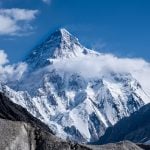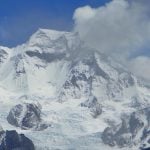Mount Gasherbrum IV: The Shining Wall of Karakoram
Gasherbrum IV. Say the name out loud and watch a mountaineer pause. This is not just another peak in the Himalayas or Karakoram. This is a legend — a mystical, nearly 8,000-meter-high fortress of ice, rock, and wind that stands between ambition and obsession. With an elevation of 7,925 meters (26,001 feet), Gasherbrum IV doesn’t quite make the “eight-thousander” club, yet it has gained a cult status among elite alpinists. Why? Because climbing Gasherbrum IV isn’t just about altitude — it’s about facing one of the most technically demanding and mentally punishing mountains on Earth. Mount Gasherbrum IV: The Shining Wall of Karakoram
Where is Gasherbrum IV? Geography of the Giant
Gasherbrum IV is located in Gilgit-Baltistan, northern Pakistan, nestled in the Karakoram Range, just a stone’s throw from K2. The mountain rises from the massive Baltoro Glacier, among a cluster of Gasherbrum peaks. The name “Gasherbrum” derives from the Balti language and means “Shining Wall” — a direct reference to the mountain’s awe-inspiring west face, a sheer 2,500-meter vertical wall of ice and granite that catches the sun like polished steel.
This face alone is enough to make climbers lose sleep — and some have never returned from it.
Technical Profile: Why Gasherbrum IV is a Mountaineer’s Mountain
Elevation: 7,925 m (26,001 ft)
Prominence: 700 m
Range: Karakoram
First Ascent: 1958 by Walter Bonatti & Carlo Mauri (Italy)
Coordinates: 35°43′00″N 76°39′00″E
Gasherbrum IV’s claim to fame isn’t just its height — it’s the technical difficulty of its routes. The west face (Shining Wall) is considered one of the hardest alpine faces in the world. It involves high-angle ice, unstable mixed terrain, exposure to avalanches, and nearly no bailout options once you’re committed.
Weather in the Karakoram is notoriously volatile. You might be pinned down in your tent for a week straight at 7,000 meters, watching food and morale dwindle. Climbing here is not just a physical test, but a psychological crucible.
First Ascent: A Bold Statement in Alpinism
The first successful ascent of Gasherbrum IV came in 1958, when Italian climbers Walter Bonatti and Carlo Mauri summited via the northeast ridge. Their expedition, led by Riccardo Cassin, was one of the most ambitious alpine-style climbs of the era — a testament to skill, grit, and innovation. Bonatti’s climb of Gasherbrum IV remains a milestone in mountaineering history, and has inspired generations of climbers to push beyond perceived limits.
How high is Gasherbrum IV?
Gasherbrum IV stands at 7,925 meters above sea level.
Which country is Gasherbrum IV in?
It is located in Pakistan, near the Chinese border, in the Karakoram Mountains.
How many people have climbed Gasherbrum IV?
Very few. The number of successful ascents remains low due to the extreme difficulty and technical nature of the mountain.
When is the best time to climb Gasherbrum IV?
The best climbing season is late June to early August, during the short Karakoram summer.
Is Gasherbrum IV harder than Everest?
Technically, yes. Everest is higher, but Gasherbrum IV is significantly more difficult to climb, especially via its Shining Wall route.
Why Is Gasherbrum IV So Legendary?
There are mountains you climb for prestige, and then there are mountains you climb for something deeper. Gasherbrum IV is the latter. It doesn’t care how many peaks you’ve summited or how expensive your gear is. It demands humility, respect, and razor-sharp focus. Many expeditions have turned back — not because of failure, but because they knew when to listen to the mountain.
Even those who haven’t reached the summit often describe the attempt as life-altering. The beauty of the Shining Wall at sunrise, the endless white silence above Camp III, the feel of wind sharp as glass — these are things that stay with you forever.
A Note to the Aspiring Climber: This Mountain Chooses You
Gasherbrum IV isn’t a peak you conquer — it’s a journey you endure. It’s a trial by ice, wind, and time. If you’re going to attempt it, do so not for the fame or Instagram likes, but because something inside you needs to know what you’re made of.





